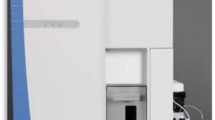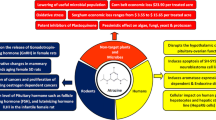Abstract
A liquid chromatography with electrospray ionization tandem mass spectrometry method was developed and validated for the determination of dioctyldiethylenetriamine acetate in soil and tobacco. The separation was performed on a Restek Ultra AQ C18 column (2.1 × 100 mm i.d., particle size 3 µm) at 40 °C with a gradient elution. Methanol and trifluoroacetic acid (0.1%) were used as mobile phase, and the flow rate was set at 0.3 mL min−1. A modified quick, easy, cheap, effective, rugged, and safe (QuEChERS) method was used for sample extraction and cleanup pretreatment. The recovery was tested in the real samples and calculated to be 86.3–97.4%, the relative standard deviations were 1.1–11.9%. The limits of detection and quantitation were 3.3–16.7 and 10–50 µg kg−1, respectively. The method was demonstrated to be reliable for the routine monitoring of dioctyldiethylenetriamine acetate in tobacco samples.



Similar content being viewed by others
References
Ren FX, Cai CC (2010) Determination of 1.8% dioctyldiethylenetriamine acetate aqueous solutions by GC. Appl Chem 39:1098–1099
Li XS, Xu J, Pan CP, Shan WL, Li GP, Chen TC, Ye JM (2009) Qualitative analysis of dioctyldiethylenetriamine acetate and its primary impurities in technical concentrate and the quantitative analytical method for dioctyldiethylenetriamine acetate. Pest Sci Admin 30:8–13
Li LK, Yuan SK, Yan QP, Cui XL, Jiang H (2010) Study on the anti-microbial activity of Xinjunan to 15 plant pathogens. Pest Sci Admin 31:32–34
Anastassiades M, Lehotay SJ, Stajnbaher D, Schenck FJ (2003) Fast and easy multiresidue method employing acetonitrile extraction/partitioning, “dispersive solid-phase extraction” for the determination of pesticide residues in produce. J AOAC Int 86:412–431
Cunha SC, Lehotay SJ, Mastovska K, Fernandes JO, Beatriz M, Oliveira PP (2007) Evaluation of the QuEChERS sample preparation approach for the analysis of pesticide residues in olives. J Sep Sci 30:620–632
Pareja L, Cesio V, Heinzen H, Fernández-Alba AR (2011) Evaluation of various QuEChERS based methods for the analysis of herbicides and other commonly used pesticides in polished rice by LC–MS/MS. Talanta 83:1613–1622
Schenck FJ, Hobbs JE (2004) Evaluation of the quick, easy, cheap, effective, rugged, and safe (QuEChERS) approach to pesticide residue analysis. Bull Environ Contam Toxicol 73:24–30
Li XX, Jiang YP, Shan WL, Pan CP (2010) Dissipation and residues detection of dioctyldiethylenetriamine acetate in rice plant and environment by QuEChERS method and liquid chromatography/electrospray tandem mass spectrometry. Bull Environ Contam Toxicol 84:596–601
Koesukwiwat U, Lehotay SJ, Mastovska K, Dorweiler KJ, Leepipatpiboon N (2010) Extension of the QuEChERS method for pesticide residues in cereals to flaxseeds, peanuts, and doughs. J Agric Food Chem 58:5950–5958
Marchis D, Ferro GL, Brizio P, Squadrone S, Abete MC (2012) Detection of pesticides in crops: a modified QuEChERS approach. Food Control 25:270–273
Costa FP, Caldas SS, Primel EG (2014) Comparison of QuEChERS sample preparation methods for the analysis of pesticide residues in canned and fresh peach. Food Chem 165:587–593
Eeckhaut AV, Lanckmans K, Sarre S, Smolders I, Michotte Y (2009) Validation of bioanalytical LC–MS/MS assays: evaluation of matrix effects. J Chromatogr B 877:2198–2207
Gros M, Petrović M, Barceló D (2006) Development of a multi-residue analytical methodology based on liquid chromatography—tandem mass spectrometry (LC–MS/MS) for screening and trace level determination of pharmaceuticals in surface and wastewaters. Talanta 70:678–690
Stubbings G, Bigwood T (2009) The development and validation of a multiclass liquid chromatography tandem mass spectrometry (LC–MS/MS) procedure for the determination of veterinary drug residues in animal tissue using a QuEChERS (QUick, Easy, CHeap, Effective, Rugged and Safe) approach. Anal Chim Acta 637:68–78
Sack C, Smoker M, Chamkasem N, Thompson R, Satterfield G, Masse C, Mercer G, Neuhaus B, Cassias I, Chang E, Lin Y, MacMahon S, Wong J, Zhang K, Smith RE (2011) Collaborative validation of the QuEChERS procedure for the determination of pesticides in food by LC–MS/MS. J Agric Food Chem 59:6383–6411
Gilart N, Marcé RM, Borrull F, Fontanals N (2012) Determination of pharmaceuticals in wastewaters using solid-phase extraction-liquid chromatography-tandem mass spectrometry. J Sep Sci 35:875–882
National Food Administration (2016) Method validation and quality control procedures for pesticide residues analysis in food and feed (SANTE/11945/2015), Uppsala. http://www.eurl-pesticides.eu/library/docs/allcrl/AqcGuidance_SANTE_2015_11945.pdf. Accessed 3 Mar 2018
Rahman MM, Farha W, Abd El-Aty AM, Kabir MH, Im SJ, Jung DI, Choi JH, Kim SW, Son YW, Kwon Ch, Shin HC, Shim JH (2015) Dynamic behavior and residual pattern of thiamethoxam and its metabolite clothianidin in Swiss chard using liquid chromatography–tandem mass spectrometry. Food Chem 174:248–255
Ramasubramanian T, Paramasivam M, Jayanthi R (2012) Rapid and sensitive analytical method for simultaneous determination of imidacloprid and thiamethoxam residues in soils of sugarcane ecosystem by reversed-phase HPLC. Water Air Soil Pollut 223:6045–6050
Nie YH, Zhang KK, Chen HY, Zhang W, Zhu HJ, Hu DY (2015) Dissipation and residue fate of kresoxim-methyl in tobacco leaves and soil under field conditions. Int J Environ Anal Chem 95:1338–1352
Liu JS, Liu JL (2010) Practical guide to leaf tobacco production techniques in China. China National Leaf Tobacco Corporation, Beijing
Cabrera LC, Caldas SS, Prestes OD, Primel EG, Zenella R (2016) Evaluation of alternative sorbents for dispersive solid-phase extraction clean-up in the QuEChERS method for the determination of pesticide residues in rice by liquid chromatography with tandem mass spectrometry. J Sep Sci 39:1945–1954
Xiang QY, Hashi Y, Chen ZL (2016) Simultaneous detection of eight active components in Radix Tinosporae by ultra high performance liquid chromatography coupled with electrospray tandem mass spectrometry. J Sep Sci 39:2036–2042
Xu JJ, Zhou J, Huang BF, Cai ZX, Xu XM, Ren YP (2016) Simultaneous and rapid determination of deoxynivalenol and its acetylate derivatives in wheat flour and rice by ultra high performance liquid chromatography with photo diode array detection. J Sep Sci 39:2028–2035
Yang ZZ, Wang L, Xu MC, Gu JK, Yu LS, Zeng S (2016) Simultaneous analysis of gemfibrozil, morphine, and its two active metabolites in different mouse brain structures using solid-phase extraction with ultra-high performance liquid chromatography and tandem mass spectrometry with a deuterated internal standard. J Sep Sci 39:2087–2096
Li MM, Liu XG, Dong FS, Xu J, Kong ZQ, Li YB, Zheng YQ (2013) Simultaneous determination of cyflumetofen and its main metabolite residues in samples of plant and animal origin using multi-walled carbon nanotubes in dispersive solid-phase extraction and ultrahigh performance liquid chromatography-tandem mass spectrometry. J Chromatogr A 1300:95–103
Zhang ZY, Jiang W, Jian Q, Song WC, Zheng ZT, Wang DL, Liu XJ (2015) Residues and dissipation kinetics of triazole fungicides difenoconazole and propiconazole in wheat and soil in Chinese field. Food Chem 168:396–403
Feinberg M, Boulanger B, Dewé W, Hubert P (2004) New advances in method validation and measurement uncertainty aimed at improving the quality of chemical data. Anal Bioanal Chem 380:502–514
Taverniers I, De Loose M, Bockstaele EV (2004) Trends in quality in the analytical laboratory. II. Analytical method validation and quality assurance. Trends Anal Chem 23:535–552
Funding
This study was funded by the National Key Research and Development Program of China (Grant number 2016YFD0200203-3).
Author information
Authors and Affiliations
Corresponding authors
Ethics declarations
Conflict of interest
Jin Gong declares that he has no conflicts of interest. Guoqiang Yang declares that he has no conflicts of interest. Weiwei Yu declares that she has no conflicts of interest. Min Huang declares that she has no conflicts of interest. Fuqin Li declares that she has no conflicts of interest. Mingjiao Jin declares that she has no conflicts of interest. Deyu Hu declares that she has no conflicts of interest. Kankan Zhang declares that he has no conflicts of interest.
Ethical approval
This article does not contain any studies with human participants or animals performed by any of the authors.
Electronic supplementary material
Below is the link to the electronic supplementary material.
Rights and permissions
About this article
Cite this article
Gong, J., Yang, G., Yu, W. et al. The Development and Validation of a Liquid Chromatography–Tandem Mass Spectrometry Procedure for the Determination of Dioctyldiethylenetriamine Acetate Residues in Soil, Green and Cured Tobacco Leaves Using a Modified QuEChERS Approach. Chromatographia 81, 1035–1041 (2018). https://doi.org/10.1007/s10337-018-3535-z
Received:
Revised:
Accepted:
Published:
Issue Date:
DOI: https://doi.org/10.1007/s10337-018-3535-z




